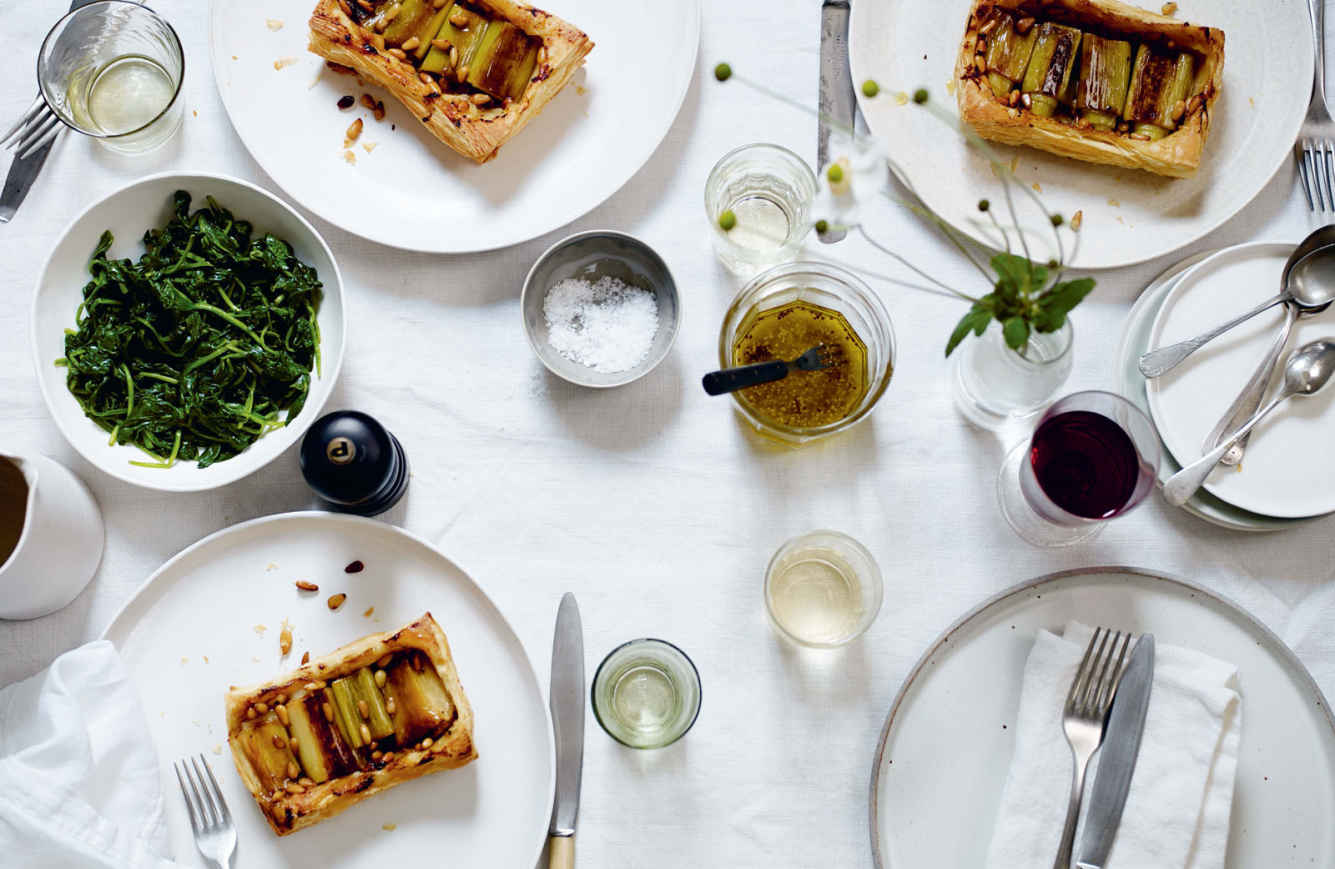Leeks are a great vegetable, although they are known as ‘poor man’s asparagus’. This seems unfair, as they can hold their own against the posh spears any day. Try serving this tart with wild garlic; if you can find the leaves at farmer’s markets, take the opportunity to buy more than you need, as they are quite versatile and interesting. Try slicing them thinly and adding to a soup just before serving, or toss in warm oil and fold into pasta. Or fold them into scrambled eggs when they are cooking and serve on hot buttered toast. If you cannot find any wild garlic, substitute with spinach and a finely chopped garlic clove; not the same but still tasty.
You can add little touches depending on the occasion, situation or your general mood. Perhaps balance a fried egg on top, or sprinkle with grated cheese. A nice fresh Kohlrabi, gherkin and apple salad (see here) would complete the meal.
SERVES 4
60g unsalted butter
4 large leeks, peeled, trimmed and washed
finely grated zest and juice of 1 unwaxed lemon
sea salt and freshly ground black pepper
plain flour, to dust
250g packet of puff pastry
100g pine nuts, toasted
1 tbsp sunflower oil
200g wild garlic, washed
(or 200g baby leaf spinach and 1 garlic clove, finely chopped)
In a large frying pan, melt the butter over a medium heat. While it melts, cut each leek into four lengths so that you finish with 16 lengths, trying to keep them as equal in size as possible. (Keeping them this size as opposed to in small discs prevents them from falling apart.)
When the butter has melted and has stopped bubbling and hissing, add the leeks to the pan with the lemon zest and juice. Season well. Keep the heat on medium to prevent the leeks catching or falling apart. Allow them to gently bubble in the butter and their own juices, which will start to appear, giving them a turn every 3 minutes so they cook evenly; they should be ready in 12–15 minutes.
To tell if the leeks are cooked, pierce them with a knife: they should be soft to the centre. Nothing worse than undercooked leeks. Set aside in the butter and juices.
Preheat the oven to 180°C/fan 160°C/gas mark 4.
Meanwhile, prepare the pastry. On a lightly floured worktop, roll out the pastry to a 30 x 20cm rectangle or thereabouts – this does allow for a little waste.
Now slice the rectangle into four smaller rectangles; we find using one of those pizza cutters is really good for cutting pastry. Take a baking tray with low sides which is able to fit the four pastry rectangles.
Lay four lengths of leek next to each other on the tray, almost as if you are trying to create a rectangle that is a similar size to the pastry but a little smaller. This sounds strange but trust me.
Next spoon 1 tbsp of the buttery lemon stock on each leek rectangle, don’t worry if it runs off. Now sprinkle on most of the pine nuts; keep some to use as a garnish.
Lay a sheet of pastry on top of each pile of leeks. The pastry should be a little larger than the leeks; it if isn’t just push the leeks a little closer together.
Bake in the hot oven for 10–12 minutes; the pastry should be golden and risen. Remove from the oven and allow to settle.
Using the same frying pan to save washing up, discard the remaining leek stock and butter, but do not wash or rinse the pan; some of the flavour will help.
Add the sunflower oil to the pan, heat until the spitting subsides, then add the wild garlic and season. It will seem like a lot of greens but will soon wilt down; turn it in the pan with a wooden spoon to ensure it is cooked equally. If you are using spinach, add the chopped garlic first for a minute, stirring, then continue to wilt the spinach in the same way.
To serve, slide a fish slice under a tart to make sure you catch all the leeks and very carefully turn it so that the pastry becomes the base; use your hand to guide it but be careful of the hot butter and juices. (Baking it this upside-down way ensures that you have a crispy base.)
Place each tart on a plate and sprinkle with the remaining pine nuts. Arrange the wilted garlic (or spinach) on top, or serve it alongside.








